In this post, we’ll explain the changes to the racing rules of sailing 2021-2024. World Sailing revises the rules every four years, and normally publishes them after the completion of an Olympic quad cycle. We didn’t get to complete an Olympic quad cycle in 2020, but the rules changes will still occur in 2021.
Watch our video by clicking on the image below, or read the summary.
Scope of Discussion
As usual, there are lots of changes, but most of them are minor and have little impact on sailors during a race. For this post, we’ll focus on the changes that affect one-design sailors, either on the water or related to scoring.
We’ll show the marked up change, explain why it was made, and discuss any potential impact on your sailing.
If you want to dig into all the detailed changes, go to the World Sailing website for the study version of the rules changes.
Racing Rules of Sailing 2021-2024 Highlights
- The racing rules of sailing 2021-2024 took effect on January 1, 2021.
- Start and finish now occur when any part of the hull is over the line; the boat’s crew and equipment were removed from the definition.
- Sail the course definition was added. This will allow RC to score you as NSC without protesting and holding a hearing. You can still request redress.
- Exoneration is clarified and consolidated in a new rule 43.
- A solid blue flag replaces the orange flag for the finish line, unless changed in the sailing instructions.
- The code flag V requires competitors to monitor the RC channel for search and rescue instructions. Race committees should ensure this flag is available.
- In order to be granted redress for the actions of another boat, the other boat must have taken an appropriate penalty or have been penalized for violations of Rules 2 or 69. You may have to protest the boat to ensure this is the case.
- There is a significant shift in the importance of the notice of race (NoR) in the new rules. The NoR may now contain more information, such as rules that a boat must comply with before the event, rules that would help competitors decide whether to attend the event, and information that they will need before the sailing instructions become available. This information does not need to be repeated in the sailing instructions. Be sure you read the NoR.
- The RC or protest committee can use the notice board to announce their protest of a boat. Be sure you review the notice board and/or have access to any electronic notice boards.
- Support persons (e.g., coaches, parents) are now required to give aid to boats (Rule 1.1), and are prohibited from disposing trash on-water (Rule 47). A boat can seek redress for the actions of another boat’s support persons.
Discussion of Changes
In these sections, we present the modified rules with additions shown in red and deletions shown with strike-outs.
Definitions
Start
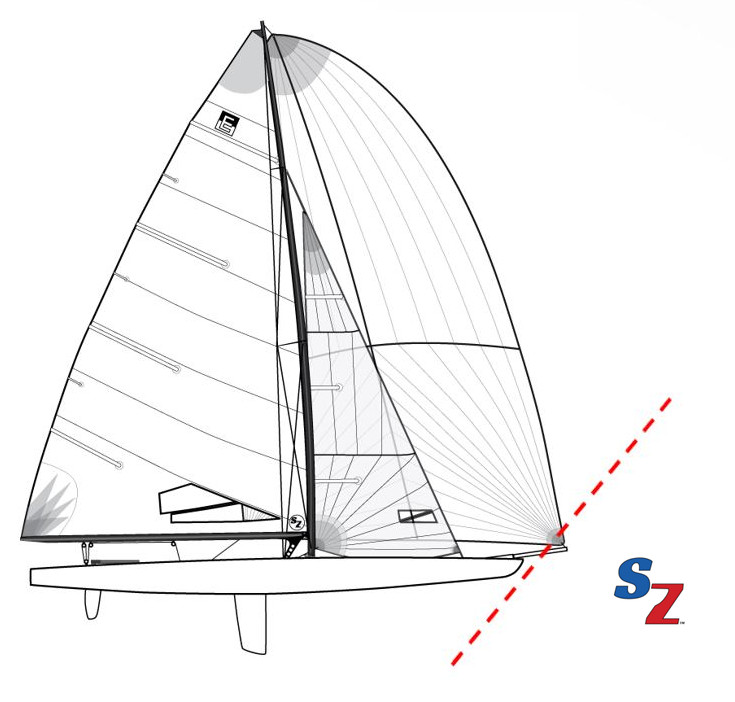
“A boat starts when her hull, having been entirely on the pre-start side of the starting line at or after her starting signal, and having complied with rule 30.1 if it applies, any part of her hull, crew or equipment crosses the starting line from the pre-start side to the course side in the direction of the first mark.”
Rationale and Impact
- Eliminating crew and equipment from the definition makes it easier for the RC to identify boats that are over. Equipment such as bow sprits are harder to correlate with a specific boat.
- “Hull” is not defined, but is likely to be interpreted in accordance with the Equipment Rules for Sailing.
- The same change is made for the definition of finish and rules 29 and 30 regarding recalls and starting penalties.
Sail the course – new definition
“A boat sails the course provided that a string representing her track from the time she begins to approach the starting line from its prestart side to start until she finishes, when drawn taut, (a) passes each mark of the course for the race on the required side and in the correct order, (b) touches each mark designated in the sailing instructions to be a rounding mark, and (c) passes between the marks of a gate from the direction of the course from the previous mark.”
Rationale and Impact
- Clarifies the meaning of sail the course throughout the RRS. Removes the “string rule” portion of Rule 28.
- The requirement to sail the course is now included in Rule 28.1.
- Allows RC to score a boat NSC without needing to protest her under Rule 28. A boat may still request redress.
- As a sailor, you may only learn of being scored NSC by reading the posted score sheet. You need to be aware of the time limits for requesting redress (Rule 62.2):
- As soon as possible after learning of the reasons for making the request.
- On last day of racing, no later than 30 minutes after the decision is posted.
Part 1 – Fundamental Rules
Changes for 2021-2024 are shown in red.
Rule 1.1, Helping those in danger
“A boat, or competitor or support person shall give all possible help to any person or vessel in danger.”
Rationale and Impact
- Adds this obligation for support persons.
- Support persons include coaches and parents/guardians of competitors.
Rule 2, Fair Sailing
“A boat and her owner shall compete in compliance with recognized principles of sportsmanship and fair play. A boat may be penalized under this rule only if it is clearly established that these principles have been violated. The penalty shall be either disqualification or a disqualification that is not excludable.”
Rationale and Impact
- World Sailing determined that a breach of Rule 2 should result in a non-excludable disqualification (scored as DNE).
Part 2 – When Boats Meet
Rule 14, Avoiding Contact
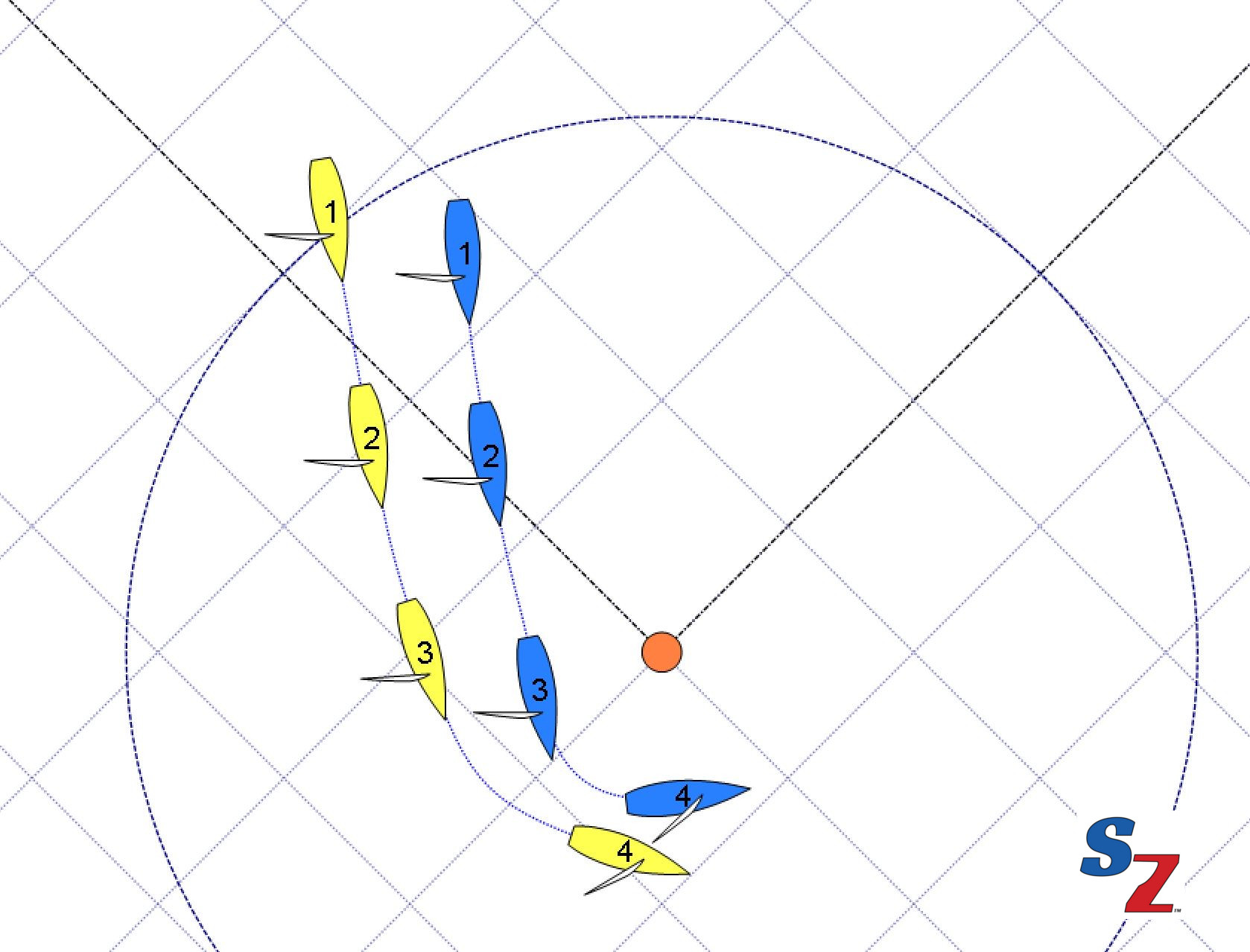
“A boat shall avoid contact with another boat if reasonably possible. However, a right-of-way boat, or one entitled to sailing within the room or mark-room to which she is entitled, (a) need not act to avoid contact until it is clear that the other boat is not keeping clear or giving room or mark-room. and (b) shall be exonerated if she breaks this rule and the contact does not cause damage or injury.“
Rationale and Impact
- In mark rounding situations, you are only protected by this rule if you are sailing within the room to which you are entitled. See the example.
- Exoneration moved to Rule 43
Rule 16, Changing Course
“16.1 When a right-of-way boat changes course, she shall give the other boat room to keep clear.
16.2 In addition, on a beat to windward when after the starting signal a port-tack boat is keeping clear by sailing to pass astern to leeward of a starboard-tack boat, the starboard-tack boat shall not change course bear away if as a result the port-tack boat would immediately need to must change course immediately to continue keeping clear.”
Rationale and Impact
- Rule 16.1 requires a right-of-way boat to give room to keep clear when changing course in all situations and is not changed.
- Wording in 16.2 was revised to specifically address bearing off past 90 degrees to the true wind to hunt a boat on a beat to windward. This is a common tactic in team racing. The rule now applies when the port tack boat is sailing to pass to leeward of the starboard tack boat. Thus, the starboard boat can no longer turn this rule off by bearing off below 90 degrees to the true wind.
- Removing the words “after the starting signal” has no effect, since on a beat to windward is not interpreted to include the period before the start.
Rule 18.1, When Rule 18 (Mark-Room) Applies
“Rule 18 applies between boats when they are required to leave a mark on the same side and at least one of them is in the zone. However, it does not apply
(a) between boats on opposite tacks on a beat to windward,
(b) between boats on opposite tacks when the proper course at the mark for one but not both of them is to tack,
(c) between a boat approaching a mark and one leaving it, or
(d) if the mark is a continuing obstruction, in which case rule 19 applies.
Rule 18 no longer applies between boats when mark-room has been given.“
Rationale and Impact
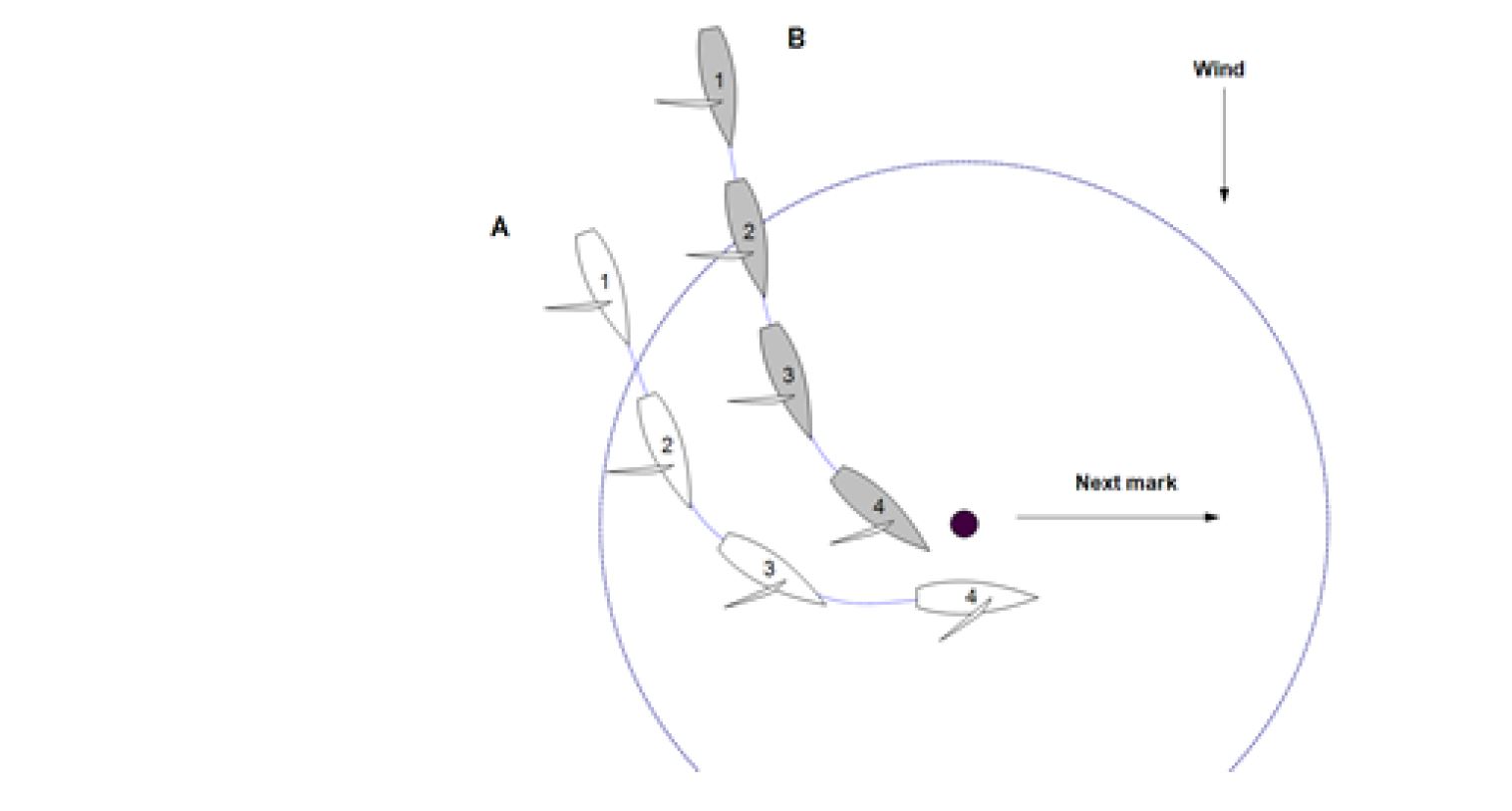
claim mark-room at position 4
- Previously, Rule 18.2(a) was not turned off when mark room was given. This change closes loophole that would allow an inside boat, not overlapped at the zone, to claim mark room under 18.2(a) after the outside boat has been given room to round the mark, when Rule 18.2 (b) turns off.
- See the example from the study version. In the situation shown, the grey boat was not overlapped with the white boat at the zone, and so was not entitled to room at the mark, in accordance with Rule 18.2(b). However, rule 18.2(b) turns off after the white boat has been given room (see Rule 18.2(d)). Once Rule 18.2(b) turns off, Rule 18.2(a) applies, which states that the inside overlapped boat is entitled to mark-room. So, at position 4, Rule 18.2(a) would grant mark-room to grey. This was not the intent envisioned by the rules. To fix this, World Sailing added text to 18.1 to turn off the entire rule once the boat entitled to room passes the mark.
Room to Tack at an Obstruction
Rule 20.4, Additional Requirements for Hails (new rule)
“20.4 (a) When conditions are such that a hail may not be heard, the boat shall also make a signal that clearly indicates her need for room to tack or her response. (b) The notice of race may specify an alternative communication for a boat to indicate her need for room to tack or her response, and require boats to use it.”
Rationale and Impact
- Recall that Rule 20.1 requires a boat to hail for room to tack at an obstruction.
- In races for large boats, or multihulls or foiling boats that can slow dramatically when they tack, boats are often so far apart when a hail must be made that it is unlikely that a verbal hail will be heard.
- This puts the onus on the hailing boat to make sure the message is conveyed.
Part 3 – Conduct of a Race
Rule 37, Search and Rescue Instructions (new rule and race signal)
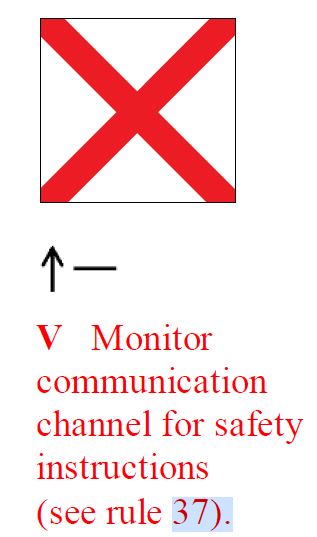
“When the race committee displays flag V with one sound, all boats and official and support vessels shall, if possible, monitor the race committee communication channel for search and rescue instructions.”
Rationale and impact
- Accompanies the use of the V flag. RC will hail boats to tune to RC channel when displaying this flag.
Part 4 – Other Requirements When Racing
Rule 43, Exoneration (new rule)
“43.1 (a) When as a consequence of breaking a rule a boat has compelled another boat to break a rule, the other boat is exonerated for her breach.
(b) When a boat is sailing within the room or mark-room to which she is entitled and, as a consequence of an incident with a boat required to give her that room or mark-room she breaks a rule of Section A of Part 2, rule 15, 16, or 31, she is exonerated for her breach.
(c) A right-of-way boat, or one sailing within the room or mark-room to which she is entitled, is exonerated for breaking rule 14 if the contact does not cause damage or injury.
43.2 A boat exonerated for breaking a rule need not take a penalty and shall not be penalized for breaking that rule.”
Rationale and Impact
- Consolidates statements from current rules 14(b), 21, and 64.1(a) into one rule.
- Wording changed from “shall be” to “is” exonerated to clarify that a protest hearing is not required.
Appendix J – Notice of Race and Sailing Instructions
Well summarize the changes here, rather than showing the markups.
- The new rules remove all requirements that a rule included in the notice of race (NoR) be repeated in the sailing instructions,
- The rules also require the NoR to contain rules a reasonable competitor would want to know when deciding whether to enter an event or when preparing for the event in the weeks before the event begins.
- This significantly increases the importance of the NoR, since the new rules also state that the provisions in the NoR do not need to be repeated in the Sailing Instructions.
- Rule 25.1 also requires that the NoR be made available to each boat before she enters an event.
Race Signals
Start and finish line flags were added to the race signals:
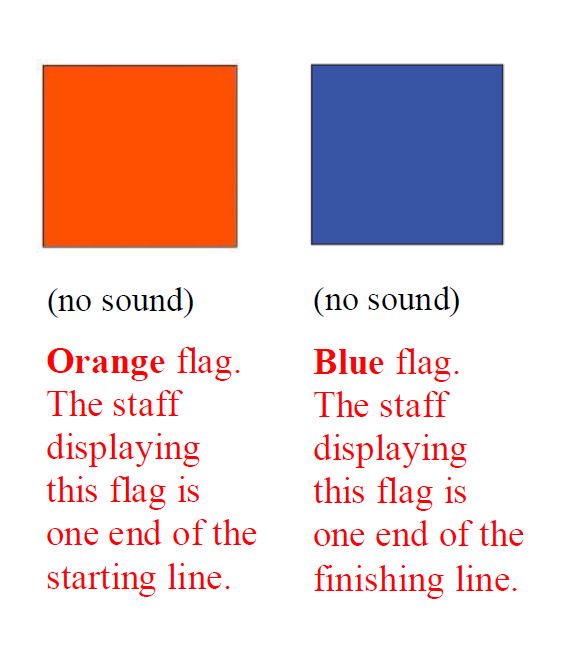
- Orange flag – one end of the starting line
- Blue flag – one end of the finish line
Rationale and Impact
- World Sailing states that these are commonly used signals. Race managers and sailors would find it useful if they were included in Race Signals.
- The blue flag has not been typically used as a finish line flag in the ILYA and its use may confuse some sailors. Sailing Instructions (SIs) should specify which flags will be used.
SailZing racing rules category
World Sailing – Racing Rules of Sailing

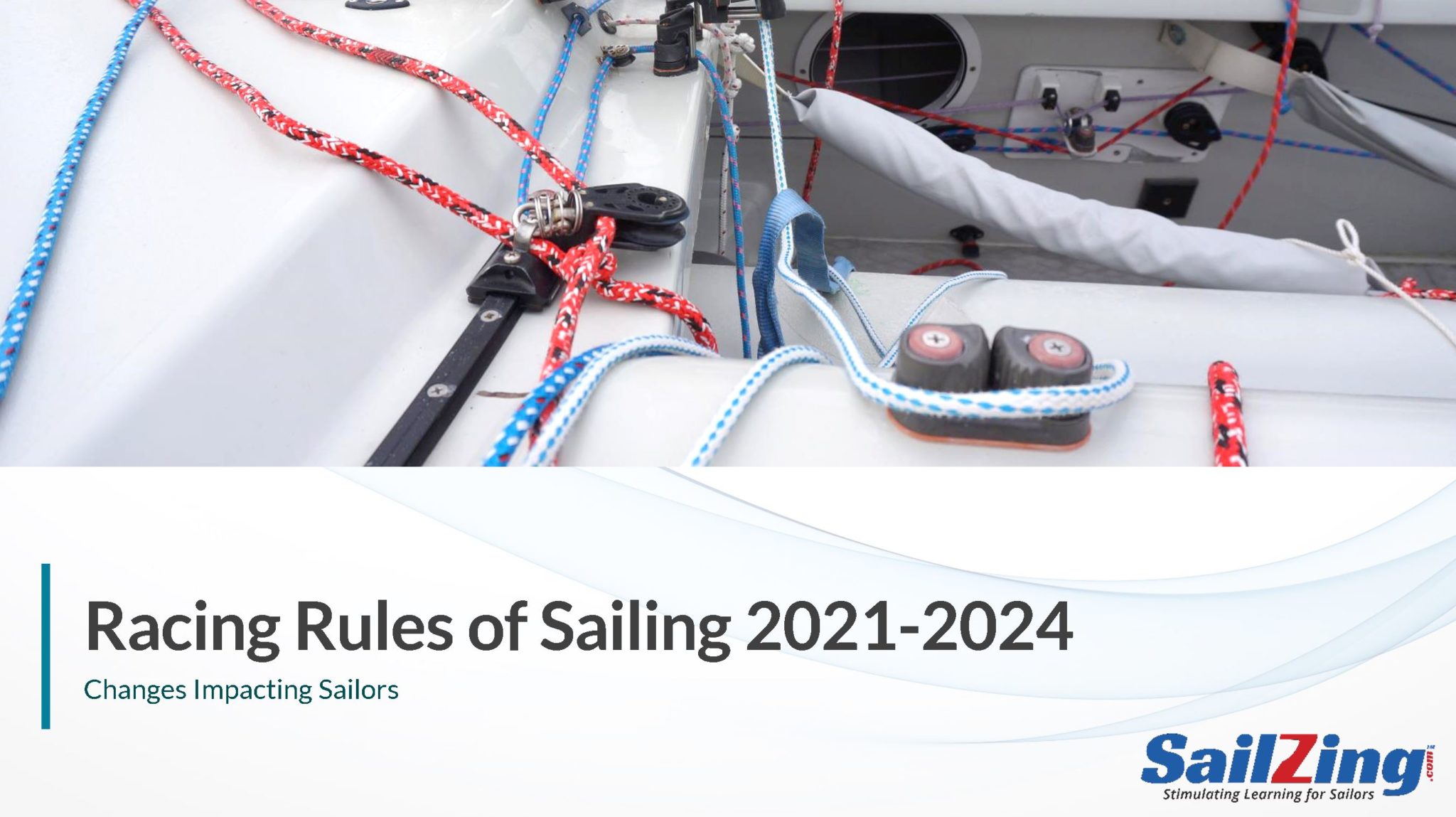

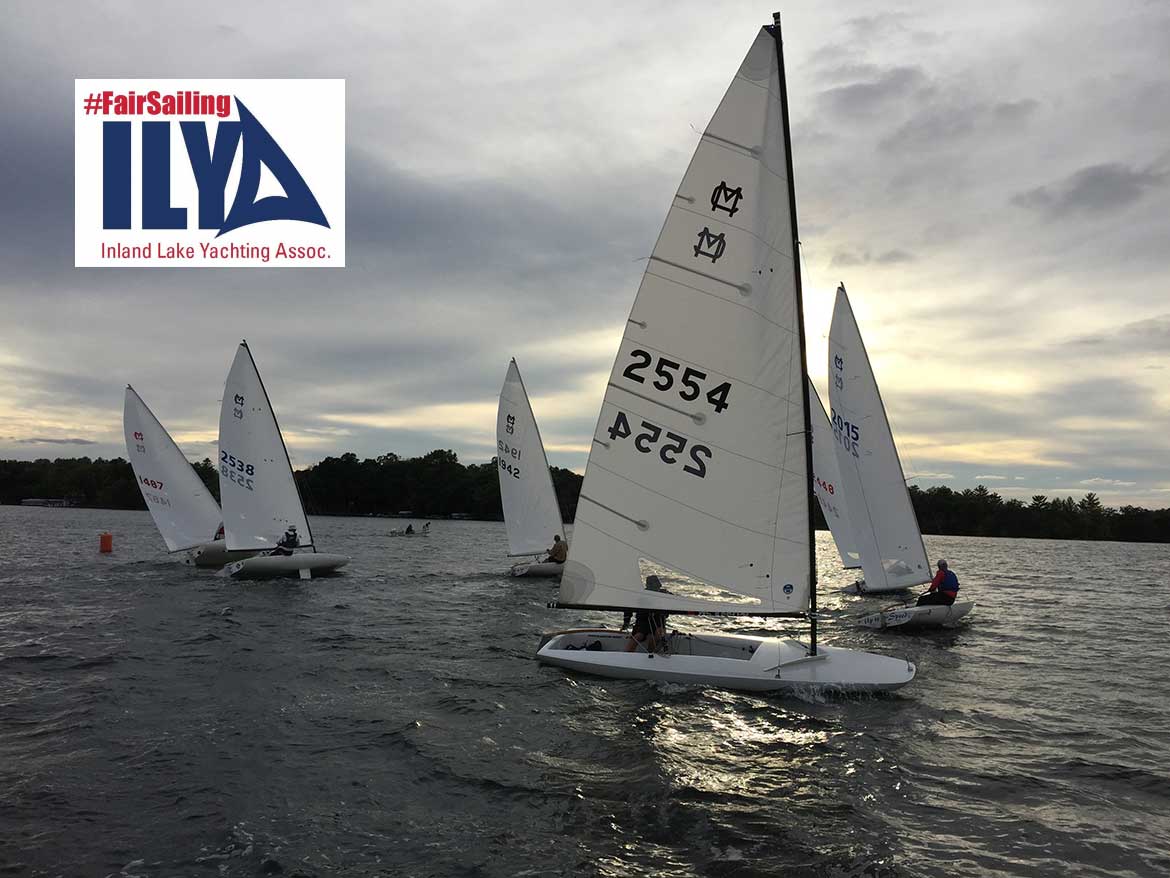
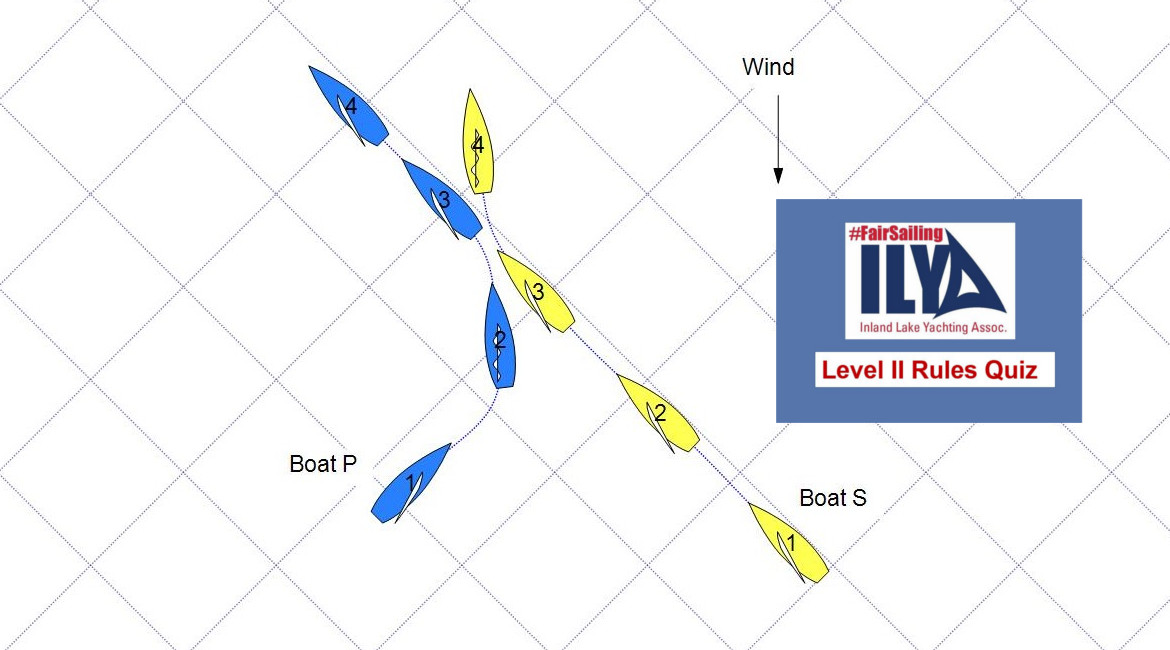

Well explained ……look forward to adopting the new rules in January —-in time for the Trainwreck
Thanks, David!